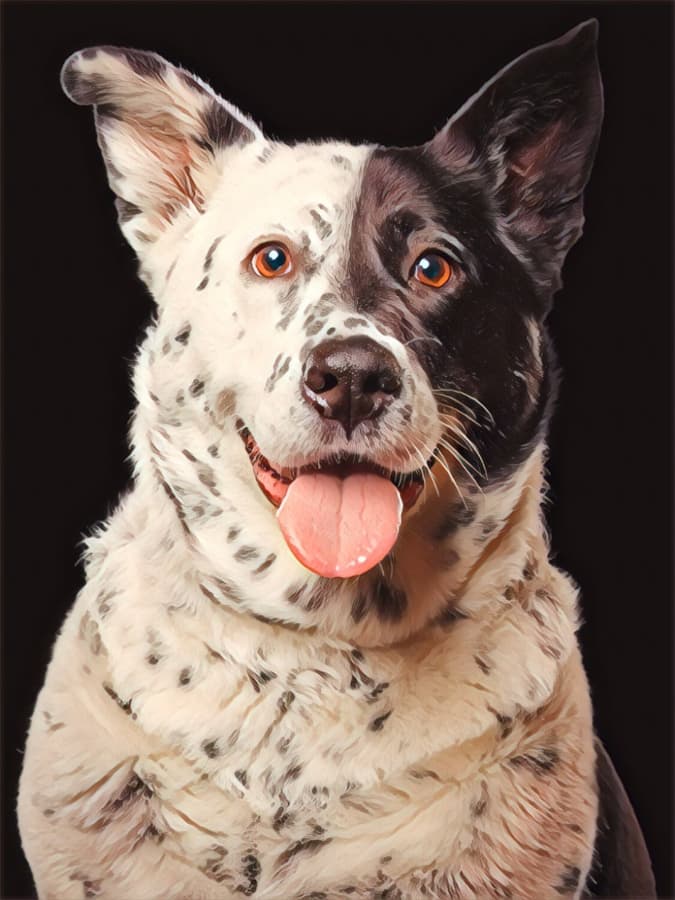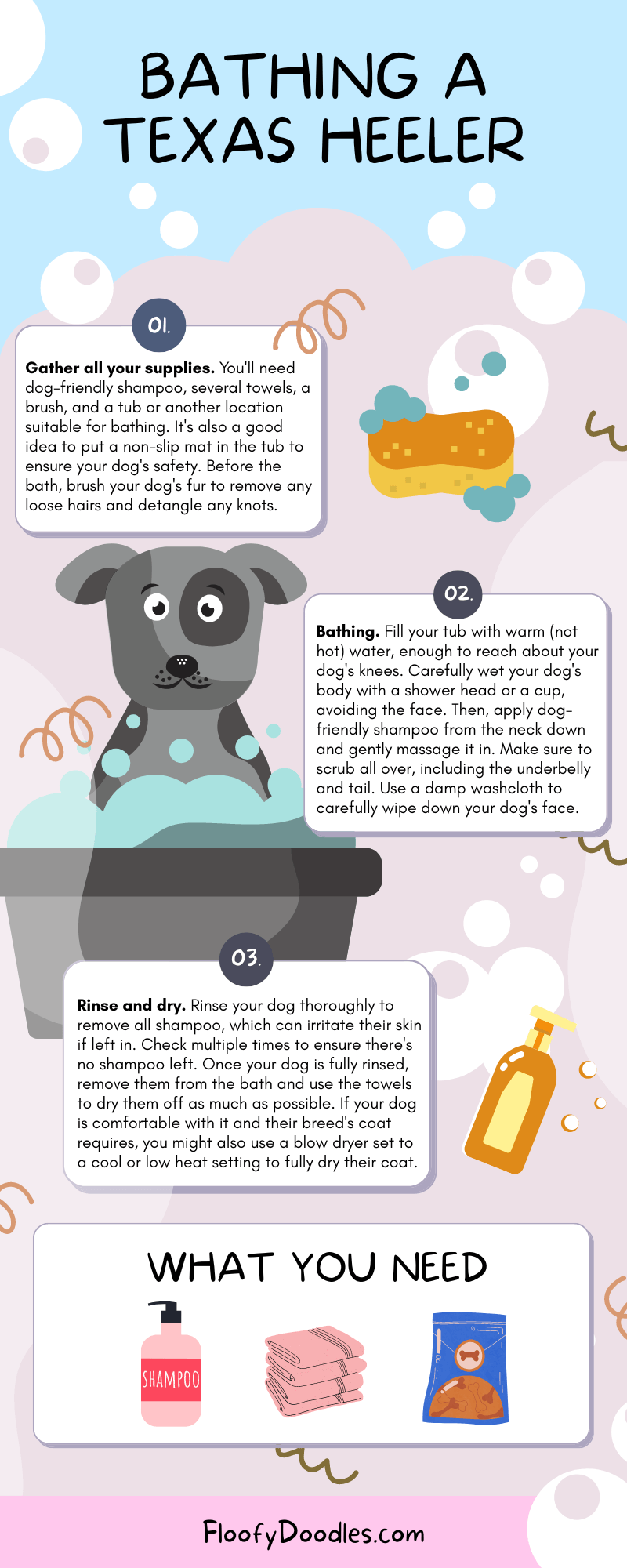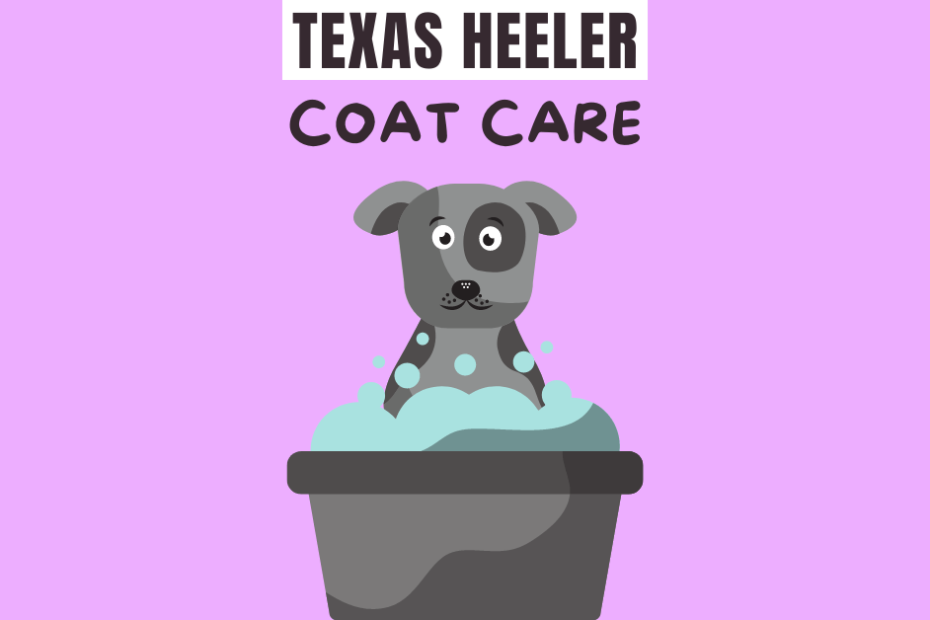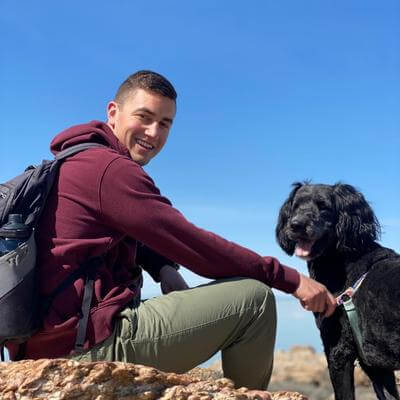Yes, the Texas Heeler sheds. They inherit those messy shedding genes as a mix between two shedding breeds, Australian Shepherd and Australian Cattle Dog!
In this article, I will walk you through the basics of the Texas Heeler coat. I will cover shedding, grooming, and other commonly asked questions.
So, get your vacuum ready, and let’s get rid of some loose fur!
Affiliate disclosure: As an Amazon Associate, I may earn commissions from Amazon.com.
Do they shed?
In my research on the Texas Heeler breed, I’ve found that they do indeed shed, but the shedding varies depending on the season.
Texas Heelers have short- to medium-length coats that are thick and double-layered. Throughout most of the year, they tend to shed moderately.
However, the shedding can become heavier during springtime when they blow their undercoats.
In some cases, this increased shedding can also occur in the fall, depending on the climate.
This means you should be prepared to see some hair around the house, especially during those peak shedding seasons.
Grooming is essential for managing the shedding of Texas Heelers.
I’ve learned that brushing their coats once or twice a week using a bristle or pin brush is good practice.
This routine helps reduce the amount of loose hair and keeps their coats healthy and tangle-free.
Additionally, grooming can be a great bonding activity for you and your Texas Heeler while ensuring their coat remains in top condition.
If you’re considering welcoming a Texas Heeler into your home (or already own one), remember that shedding is a natural part of their lifecycle.
Being prepared to groom them regularly will help manage this shedding and keep your home cleaner, creating a comfortable environment for you and your pup.
Understanding the Texas Heeler coat
As I’ve spent some time researching and talking with Texas Heeler owners, I’ve uncovered some interesting facts about their coats.
Let’s dive into Texas Heeler coats’ length, texture, and appearance.
Length
The coat of a Texas Heeler is usually short to medium in length.
This breed is a cross between an Australian Cattle Dog (also known as a Blue Heeler or Queensland Heeler) and an Australian Shepherd.

Their coat length can vary depending on which parent they take after more, but generally, they appear to have a coat length somewhere between their two parent breeds.
Texture
Drawing from the characteristics of both parents, the coat of a Texas Heeler can range from a slightly wavy texture inherited from the Aussie parent to a smoother, shorter coat akin to the ACD.
They could also possess feathering on the legs and a thicker ruff around the neck like the Aussie.
The double coat of the ACD may also feature, providing extra protection and insulation.
Texas Heelers exhibit a diverse range of coat colors. They can come in black, blue merle, red, white, and tan.
Their distinctive coat appearance often showcases speckled or mottled patterns.
Additionally, their eyes can be pretty expressive, and their ears might be upright (pricked) like the Australian Cattle Dog or folded like the Australian Shepherd.
Overall, their unique coat length, texture, and appearance are some of the reasons that make them so beloved by their owners.
How often do they shed?
In my research on Texas Heelers, I have found that they shed most of the time moderately due to their short- to medium-length double-layered coats.
As a result, regular brushing is recommended to manage the shedding and maintain their coat’s health.
Based on my conversations with Texas Heeler owners, these dogs shed even more during the spring shedding season when they blow their undercoats.
Some Texas Heelers may occasionally experience heavier shedding in the fall as well.
It’s essential to be prepared for increased shedding during these times, which means being ready to vacuum frequently and brush the dog’s coat even more regularly.
While climate, indoor or outdoor living conditions, and the dog’s overall health can influence the shedding pattern, most Texas Heelers will shed twice a year.
It’s worth noting that neutered male Texas Heelers may experience a significant decrease in shedding frequency, often shedding only once a year.
Why is my Texas Heeler shedding a lot?
There are a few possible reasons your Texas Heeler might be shedding a lot, including seasonal coat changes, allergies, stress, or parasites.
Let’s take a closer look at a few of these factors.
Blowing Their Coat
As I’ve learned in my research, Texas Heelers, like their Blue Heeler parent, have a double coat that goes through seasonal shedding to regulate body temperature.
This happens when they “blow” their undercoats, common among double-coated breeds.
These undercoats provide insulation against hot and cold temperatures, making them versatile for various climates.
Blowing their coat happens at least twice a year —typically in spring and occasionally in the fall.
Shedding can become quite heavy.
Regular brushing is recommended to remove loose hair to help minimize the fur around your home.
Allergies
Allergies can cause your Texas Heeler to shed more than usual.
Allergic reactions to certain ingredients in their food, environmental factors, or on their skin might lead to hair loss.
If you suspect your dog is experiencing allergies, it’s essential to consult with your veterinarian for guidance on diagnosis and treatment options.
Stress
Texas Heelers are sensitive dogs; stress can sometimes manifest as excessive shedding.
For example, moving to a new home or introducing a new pet or baby to the family can create anxiety for your Heeler.
In such cases, provide your dog with reassurance and a comfortable environment.
You may also consider seeking advice from a veterinarian or professional animal behavior specialist to help your dog cope with stress.
Fleas, Ticks, Mites, Lice, Etc.
Parasites, such as fleas, ticks, mites, and lice, can cause your Texas Heeler to shed more than usual.
Infestations often lead to itching and discomfort, which can cause your dog to scratch or bite at their fur, and may result in hair loss.
Regularly inspect your dog’s coat and skin for signs of these parasites.
Treatments are available through your veterinarian, who can recommend the best options for keeping your dog parasite-free.
Do they need professional grooming?
Texas Heelers shouldn’t need professional grooming. Both parent breeds do not require a haircut.
It is generally advised against ever cutting their fur. Owners can manage their Texas Heeler’s coat with routine brushing at home.
Brushing helps to remove any loose hair and keep their coat healthy.
Although professional grooming isn’t necessary for Texas Heelers, some owners might take their dogs to a groomer occasionally for other services.
Typically, grooming services may include bathing, trimming, nail clipping, and ear cleaning.
If you decide to take your Texas Heeler for professional grooming, the cost can vary depending on your location and the specific services you’d like to avail.
Maintaining their coat, nails, and ears at home is essential, even if you opt for professional grooming.
Regularly cleaning your Texas Heeler’s ears can prevent ear infections, while trimming their nails can help to maintain a healthy paw structure.
In conclusion, professional grooming is not necessary for Texas Heeler owners.
However, it’s essential to keep up with routine maintenance, including brushing their coat, cleaning their ears, and clipping their nails.
How to groom your Texas Heeler
In this section, I’ll briefly explain the best practices for grooming your Texas Heeler.
I checked out forums on both the Australian Cattle Dog and Australian Shepherd. I wanted to see what owners recommend for grooming.
I have a dog, but she’s a Poodle mix, so her fur is much different from a Texas Heeler’s coat.
Keep reading to see what I found.
Brushing
Daily brushing is crucial to keep Texas Heelers looking their best and minimize shedding.
Brushing your dog for 10-15 minutes daily with a slicker brush and metal comb is recommended.
Not only does this help to reduce the amount of hair around your home, but it also keeps your Texas Heeler’s coat healthy and tangle-free.
A lot of Aussie owners agree on using the Show Tech slicker brush.
It’s functional and at a low price. An easy investment to ensure your dog’s coat is free from dirt, tangles, and mats.
A highly recommended metal comb is the Andis comb. It’s less than $10 and will save your life when you need to tackle those nasty tangles or mats.
Below is some general guidance on using a slicker and comb for your Texas Heeler.

General brushing instructions using a slicker brush and a comb:
1. Create a Calm Environment: Pick a quiet, relaxing spot where you and your Texas Heeler can be at ease. Loose fur is a given, so choose a place where this won’t be an issue.
2. Implement Line Brushing Technique: Follow a ‘line brushing’ method for an effective grooming session.
Essentially, this involves parting a section of your dog’s coat and brushing from the created part, ensuring that all layers of your Texas Heeler’s coat are attended to.
Remember, a simple sweep down your dog’s back won’t do the trick!
3. Start from the Rear: Begin brushing at the back, starting from the rear end (the croup) and progressing towards the head.
For the legs, initiate brushing from the hock (ankle) and gradually move upwards. The goal is to always brush in the direction of hair growth.
4. Focus on Sensitive Areas: The comb’s fine teeth are perfect for tackling the area behind the ears.
The fur here is delicate and often prone to matting.
When combing this area, remember to hold the base of the hair near the skin to prevent causing discomfort to your dog.
Be sure to focus on these spots, which often include the back legs/butt area (also known as ‘pants’), the armpits, the inside of the legs, and the behind the ears.
5. Double-check Your Work: After you’ve completed the brushing session with the slicker brush, use the comb to verify that no mats or tangles are left.
If your comb gets caught, revisit the area with the slicker brush.
6. Reward your Texas Heeler: Treat your furry friend with a well-deserved reward and lots of affection after a job well done.
My go-to treats when grooming my dog are from Charlee Bear. Low-calorie and low-price, my favorite!
This positive reinforcement helps make grooming an enjoyable activity for your dog and paves the way for smoother sessions in the future.
Bathing
Bathing is an essential aspect of grooming. I suggest giving your dog a bath every few weeks or whenever they get particularly dirty.
Use a gentle dog shampoo and conditioner to avoid irritating their skin.
After bathing, towel dry your dog with strong but gentle rubbing, which helps remove dead fur.
Additionally, you can use a low heat setting on a hair dryer to ensure their coat is completely dry before proceeding to the next grooming step.

Nail and Ear Care
Proper nail and ear care are crucial to maintaining your Texas Heeler’s overall health and preventing potential issues.
I recommend regularly checking your dog’s nails and trimming them when needed, using a suitable nail clipper or grinder.
This will prevent overgrowths and ensure your dog’s comfort while walking.
As for ear care, cleaning your Texas Heeler’s ears regularly is essential to prevent infections.
You can use a dog ear cleaning solution and a soft cloth or cotton balls to clean the outer part of the ear gently.
I avoid the cotton ball route altogether and just Pet MD wipes. They are inexpensive and super easy to use.
Plus, they pay themselves back by avoiding those costly trips to the vet for an ear infections.
Avoid inserting anything into the ear canal, as this can be harmful.
Establishing a routine for brushing, bathing, and nail and ear care will benefit you and your Texas Heeler.
Can I shave my Texas Heeler?
No, shaving a Texas Heeler is not recommended. Shaving their coat may disrupt the natural insulation and protection it provides against harsh weather conditions, especially during summer or winter months.
Their double-layered coat helps to keep them cool during the hotter months, and shaving it off could make them more susceptible to overheating.
Instead of shaving, regular grooming should be enough to maintain the coat’s health and manage shedding.
A good grooming routine would involve brushing their coat at least once a week to remove dead hair and prevent matting.
During the shedding seasons, typically in spring and sometimes even in the fall, you may need to brush your Texas Heeler more frequently to keep up with the heavier shedding.
While it may be tempting to shave your Texas Heeler, it is not a recommended practice.
Instead, focus on regular grooming, a healthy diet, and using appropriate tools to manage your dog’s coat and shedding.
Is there a long-haired Texas Heeler?
The coat length of Texas Heelers can vary. Due to the variations in coat length between the parent breeds, Texas Heelers can inherit a range of coat lengths.
Australian Shepherds typically have longer fur, whereas Australian Cattle Dogs have shorter, denser coats.
When the two breeds are combined, the resulting Texas Heelers could have a coat resembling either one of the parent breeds or a combination of both.
That being said, most Texas Heelers have a medium-length coat.
This results from blending the Australian Shepherd’s longer fur with the Australian Cattle Dog’s shorter coat.
While it may not be expected, it is possible to find a Texas Heeler with a coat that leans more towards the long-haired side, resembling the Australian Shepherd more closely.
There are different generations of Texas Heelers (F1, F2, etc.). Some generations will have more Aussie genes, which could produce a litter of long-haired Texas Heelers.
In researching various dog breeds, I’ve concluded that dog coat genetics are tricky.
A long hair gene can sneak around in the background of some of these dogs, like in the long hair Pit Bull.
I haven’t done enough research to determine if a long hair Texas Heeler could result from this gene.


